Thermal–Acoustic Interaction Impacts on Crowd Behaviors in an Urban Park
Abstract
:1. Introduction
2. Materials and Methods
2.1. Study Site Overview
2.2. Procedures
2.3. Selection of the Thermal–Acoustic Environment
2.3.1. Thermal Environment
2.3.2. Acoustical Environment
2.4. Objective Measurement of the Sensory Environment
2.5. Behavioural Observation
2.6. Analysis Method
3. Results
3.1. Basic Environmental Conditions
3.2. Effects of the Thermal–Acoustic Interaction on the Number of People
3.2.1. The Number of People under the Thermal–Acoustic Interaction
3.2.2. Analysis of the Number of People under the Thermal–Acoustic Interaction
3.3. Effects of the Thermal–Acoustic Interaction on the Number of Persons Staying
3.3.1. The Number of Persons Staying under the Thermal–Acoustic Interaction
3.3.2. Analysis of the Number of Persons Staying under the Thermal–Acoustic Interaction
3.4. Effects of the Thermal–Acoustic Interaction on the Path Offset
3.4.1. The Path Offset under the Thermal–Acoustic Interaction
3.4.2. Analysis of the Path Offset under the Thermal–Acoustic Interaction
3.5. Effects of the Thermal–Acoustic Interaction on Crowd Speed
3.5.1. Crowd Speed under the Thermal–Acoustic Interaction
3.5.2. Analysis of Crowd Speed under the Thermal–Acoustic Interaction
4. Discussion
4.1. Interactions of the Thermal and Acoustic Environment on Crowd Behaviours
4.2. Shortcomings and Prospects
5. Conclusions
- (1)
- In terms of the number of people, favorable acoustics can attract larger crowds. Stimulating sounds, like grass cutting, reduce the crowd size under high heat. Moreover, excluding adverse noises, urban park soundscapes do not significantly impact visitor attraction across temperatures.
- (2)
- Regarding the number of persons staying, high temperatures reduce sightseeing interest, especially with a suboptimal soundscape, prompting departure. Additionally, apart from hot weather, park acoustics do not markedly influence the stay duration.
- (3)
- With respect to the path offset, the acoustic quality determines visitor proximity to sound sources as shown by the path offset, while significant differences emerged in the path offset for grass cutting at varying temperatures, most prominently under high heat. In contrast, natural sounds and music playback do not significantly impact the path offset across temperatures. Under low heat, music and nature do not differ, but both substantially differ from grass cutting, causing the greatest offset. Under moderate heat, nature and grass cutting are analogous, while music attracts visitors. However, under high heat, music and nature are similar but markedly differ from grass cutting, greatly affecting the path offset.
- (4)
- In terms of crowd speed, appealing soundscapes attract and slow tourists to enjoy the park. Moreover, higher temperatures are associated with slower walking. All sound types significantly affect the speed across the three temperature levels. While in moderate heat, speed is consistently faster than in low or high heat. In contrast, in low and moderate heat, music and nature do not significantly differ but substantially differ from grass cutting, where speed is fastest. However in high heat, sound types do not significantly differ.
Author Contributions
Funding
Data Availability Statement
Conflicts of Interest
References
- Ma, T.; Sun, S.; Fu, G.; Hall, J.W.; Ni, Y.; He, L.; Yi, J.; Zhao, N.; Du, Y.; Pei, T.; et al. Pollution exacerbates China’s water scarcity and its regional inequality. Nat. Commun. 2020, 11, 650. [Google Scholar] [CrossRef] [PubMed]
- Sun, S.; Zheng, X.; Liu, X.; Wang, Z.; Liang, L. Global pattern and drivers of water scarcity research: A combined bibliometric and geographic detector study. Environ. Monit. Assess. 2022, 194, 523. [Google Scholar] [CrossRef] [PubMed]
- Awasthi, A.K.; Li, J.; Koh, L.; Ogunseitan, O.A. Circular economy and electronic waste. Nat. Electron. 2019, 2, 86–89. [Google Scholar] [CrossRef]
- Fucheng, Y.; Jichang, Y.; Yuehong, W.; Dawei, C. Site environmental assessment to an old paint factory in China. Environ. Monit. Assess. 2008, 139, 93–106. [Google Scholar]
- Kastner, J. The new baby boom. Soap Perfum. Cosmet. 2016, 89, 19. [Google Scholar]
- Huang, Y.; Griffin, M.J. The discomfort produced by noise and whole-body vertical vibration presented separately and in combination. Ergonomics 2014, 57, 1724–1738. [Google Scholar] [CrossRef]
- Wang, C.; Geng, L.; Rodríguez-Casallas, J.D. How and when higher climate change risk perception promotes less climate change inaction. J. Clean. Prod. 2021, 321, 128952. [Google Scholar] [CrossRef]
- Shepherd, D.; Welch, D.; Dirks, K.N.; Mathews, R. Exploring the relationship between noise sensitivity, annoyance and Health-Related quality of life in a sample of adults exposed to environmental noise. Int. J. Environ. Res. Public Health 2010, 7, 3579–3594. [Google Scholar]
- King, R.P.; Davis, J.R. Community noise: Health effects and management. Int. J. Hyg. Environ. Health 2003, 206, 123–131. [Google Scholar]
- Selamat, F.E.; Tagusari, J.; Matsui, T. Mapping of transportation noise-induced health risks as an alternative tool for risk communication with local residents. Appl. Acoust. 2021, 178, 107987. [Google Scholar]
- Hong, X.-C.; Liu, J.; Wang, G.-Y. Soundscape in Urban Forests. Forests 2022, 13, 2056. [Google Scholar] [CrossRef]
- Giannaros, T.M.; Melas, D. Study of the urban heat island in a coastal Mediterranean City: The case study of Thessaloniki, Greece. Atmos. Res. 2012, 118, 103–120. [Google Scholar] [CrossRef]
- Yang, B.; Yang, X.; Leung, L.R.; Zhong, S.; Qian, Y.; Zhao, C.; Chen, F.; Zhang, Y.; Qi, J. Modeling the impacts of urbanization on summer thermal comfort: The role of urban land use and anthropogenic heat. J. Geophys. Res. D Atmos. 2019, 124, 6681–6697. [Google Scholar]
- de Souza E Silva, R.; da Silva, R.M.; de Freitas, A.F.; Dos Santos, J.S.; Santos, C.A.G.; de Lima, E.R.V. Thermal comfort conditions at microclimate scale and surface urban heat island in a tropical city: A study on Joao Pessoa city, Brazil. Int. J. Biometeorol. 2022, 66, 1079–1093. [Google Scholar] [PubMed]
- Loures, L.; Santos, R.; Panagopoulos, T. Urban parks and sustainable city Planning-The case of portimão, portugal. WSEAS Trans. Environ. Dev. 2007, 3, 171–180. [Google Scholar]
- Di, L.; Yan, S.; Yue, Y.; Yi, H.; Chengyang, X. Urban park use and self-reported physical, mental, and social health during the COVID-19 pandemic: An on-site survey in Beijing, China. Urban For. Urban Green. 2023, 79, 127804. [Google Scholar]
- Hong, X.-C.; Cheng, S.; Liu, J.; Dang, E.; Wang, J.-B.; Cheng, Y. The Physiological Restorative Role of Soundscape in Different Forest Structures. Forests 2022, 13, 1920. [Google Scholar] [CrossRef]
- Rigolon, A.; Browning, M.; Jennings, V. Inequities in the quality of urban park systems: An environmental justice investigation of cities in the United States. Landsc. Urban Plan. 2018, 178, 156–169. [Google Scholar] [CrossRef]
- Jin, Y.; Jin, H.; Kang, J. Combined effects of the thermal-acoustic environment on subjective evaluations in urban squares. Build. Environ. 2020, 168, 106517. [Google Scholar] [CrossRef]
- Chen, Y.; Liu, F.; Lin, X.; Liu, J.; Chen, Z.; Shi, K.; Li, J.; Dong, J. Combined Effects of the Thermal-Acoustic Environment on Subjective Evaluations in Urban Park Based on Sensory-Walking. Forests 2023, 14, 1161. [Google Scholar] [CrossRef]
- Guo, X.; Liu, J.; Chen, Z.; Hong, X.-C. Harmonious Degree of Sound Sources Influencing Visiting Experience in Kulangsu Scenic Area, China. Forests 2023, 14, 138. [Google Scholar] [CrossRef]
- Menatti, L.; Heft, H. Editorial: Changing Perspectives on Landscape Perception: Seeking Common Ground between the Psychological Sciences and the Humanities. Front. Psychol. 2020, 11, 159. [Google Scholar] [CrossRef] [PubMed]
- Meng, Q.; Kang, J. The influence of crowd density on the sound environment of commercial pedestrian streets. Sci. Total Environ. 2015, 511, 249–258. [Google Scholar] [CrossRef]
- Amsellem, S.; Höchenberger, R.; Ohla, K. Visual–Olfactory Interactions: Bimodal Facilitation and Impact on the Subjective Experience. Chem. Senses 2018, 43, 329–339. [Google Scholar] [CrossRef] [PubMed]
- Pellerin, N.; Candas, V. Combined effects of temperature and noise on human discomfort. Physiol. Behav. 2003, 78, 99–106. [Google Scholar] [CrossRef]
- Pellerin, N.; Candas, V. Effects of steady-state noise and temperature conditions on environmental perception and acceptability. Indoor Air 2004, 14, 129–136. [Google Scholar] [CrossRef]
- Meng, Q.; Kang, J. Effect of sound-related activities on human behaviours and acoustic comfort in urban open spaces. Sci. Total Environ. 2016, 573, 481–493. [Google Scholar] [CrossRef]
- Meng, Q.; Zhao, T.; Kang, J. Influence of Music on the Behaviors of Crowd in Urban Open Public Spaces. Front. Psychol. 2018, 9, 596. [Google Scholar] [CrossRef]
- Weifeng, Y.; Hai, T.K. A model for simulation of crowd behaviour in the evacuation from a smoke-filled compartment. Physica A 2011, 390, 4210–4218. [Google Scholar]
- Xie, H.; Kang, J.; Mills, G.H. Behavior observation of major noise sources in critical care wards. J. Crit. Care 2013, 28, 1105–1109. [Google Scholar]
- Marušić, B.G. Original Article: Analysis of patterns of spatial occupancy in urban open space using behaviour maps and GIS. Urban Des. Int. 2011, 16, 36–50. [Google Scholar] [CrossRef]
- Lepore, F.; Kostara-Konstantinou, E.; Aletta, F.; Astolfi, A. A preliminary investigation about the influence of soundscapes on people’s behaviour in an open public space. In Internoise 2016, Hamburg, 2016; Institute of Noise Control Engineering: Hamburg, Germany, 2016. [Google Scholar]
- Lavia, L.R.; Witchel, H.J.; Kang, J.; Aletta, F. Preliminary Soundscape Management Model for Added Sound in Public Spaces to Discourage Anti-Social and Support Pro-Social Effects on Public Behaviour, DAGA 2016 Conference, Aachen, 2016; DAGA: Aachen, Germany, 2016. [Google Scholar] [CrossRef]
- Aletta, F.; Lepore, F.; Kostara-Konstantinou, E.; Kang, J.; Astolfi, A. An Experimental Study on the Influence of Soundscapes on People’s Behaviour in an Open Public Space. Appl. Sci. 2016, 6, 276. [Google Scholar] [CrossRef]
- Caldwell, C.; Hibbert, S.A. Play that one again: The effect of music tempo on consumer behaviour in a restaurant. Eur. Adv. Consum. Res. 1999, 4, 58–62. [Google Scholar]
- Spangenberg, E.R.W.S.; Crowley, A.E.; Henderson, P.W. Improving the store environment: Do olfactory cues affect evaluations and behaviors? J. Mark. 1996, 60, 67–80. [Google Scholar] [CrossRef]
- Yao, X.; Yu, K.; Zeng, X.; Lin, Y.; Ye, B.; Shen, X.; Liu, J. How can urban parks be planned to mitigate urban heat island effect in “Furnace cities”? An accumulation perspective. J. Clean. Prod. 2022, 330, 129852. [Google Scholar] [CrossRef]
- Li, J.; Huang, Z.; Zheng, D.; Zhao, Y.; Huang, P.; Huang, S.; Fang, W.; Fu, W.; Zhu, Z. Effect of landscape elements on public psychology in urban park waterfront green space: A quantitative study by semantic segmentation. Forests 2023, 14, 244. [Google Scholar] [CrossRef]
- Lavandier, C.; Defréville, B. The contribution of sound source characteristics in the assessment of urban soundscapes. Acta Acust. United Acust. 2006, 92, 912–921. [Google Scholar]
- Jendritzky, G.; De, D.R.; Havenith, G. UTCI—Why another thermal index? Int. J. Biometeorol. 2012, 56, 421–428. [Google Scholar] [CrossRef]
- Blazejczyk, K.; Epstein, Y.; Jendritzky, G.; Staiger, H.; Tinz, B. Comparison of UTCI to selected thermal indices. Int. J. Biometeorol. 2012, 56, 515–535. [Google Scholar] [CrossRef]
- Peter, B.; Dusan, F.; Krzysztof, B.; Ingvar, H.; Gerd, J.; Bernhard, K.; Birger, T.; George, H. Deriving the operational procedure for the Universal Thermal Climate Index (UTCI). Int. J. Biometeorol. 2012, 56, 481–494. [Google Scholar]
- Badruddin, I.A.; Hussain, M.K.; Ahmed, N.S.; Kanesan, J.; Mallick, Z. Noise characteristics of grass-trimming machine engines and their effect on operators. Noise Health 2009, 11, 98–102. [Google Scholar] [CrossRef] [PubMed]
- Ma, J.F. The Influence of Different Music Conditions on Drivers’ Attention and Hazard Perception. Ph.D. Dissertation, Liaoning Normal University, Dalian, China, 2014. [Google Scholar]
- Tao, L. Research on the Adaptation and Application of Music to Running. Ph.D. Dissertation, Zhejiang University of Technology, Hangzhou, China, 2017. [Google Scholar]
- Zahorik, P. Assessing auditory distance perception using virtual acoustics. J. Acoust. Soc. Am. 2002, 111, 1832–1846. [Google Scholar] [CrossRef] [PubMed]
- Watzek, K.A.; Ellsworth, J.C. Perceived Scale Accuracy of Computer Visual Simulations. Landsc. J. 1994, 13, 21–36. [Google Scholar] [CrossRef]
- Husain, G.; Thompson, W.F.; Schellenberg, E.G. Effects of Musical Tempo and Mode on Arousal, Mood, and Spatial Abilities. Music Percept. 2002, 20, 151–171. [Google Scholar] [CrossRef]
- Xiao, C.W.; Ye, J.Q.; Esteves, R.M.; Rong, C.M. Using Spearman’s correlation coefficients for exploratory data analysis on big dataset. Concurr. Comput. Pract. Exp. 2016, 28, 3866–3878. [Google Scholar] [CrossRef]
- Wang, F.; Huang, G.H.; Fan, Y.; Li, Y.P. Robust Subsampling ANOVA Methods for Sensitivity Analysis of Water Resource and Environmental Models. Water Resour. Manag. 2020, 34, 3199–3217. [Google Scholar] [CrossRef]
- Tokue, Y.; Koga, K.; Nakamura, A.; Osawa, K.; Seki, K.; Imamura, F.; Nishihiro, J. Effects of hearing diverse orthoptera sounds on human psychology. Urban For. Urban Green. 2022, 73, 127512. [Google Scholar] [CrossRef]
- Zhou, L.-Y.; Schmude, J.; Zhai, P.-M.; Wang, Q. Changes in thermal comfortable condition in the Qinghai-Tibet Plateau from 1979 to 2020. Adv. Clim. Chang. Res. 2022, 13, 666–675. [Google Scholar] [CrossRef]
- Medina, D.C.; Delgado, M.G.; Amores, T.R.P.; Toulou, A.; Ramos, J.S.; Domínguez, S.Á. Climatic Control of Urban Spaces Using Natural Cooling Techniques to Achieve Outdoor Thermal Comfort. Sustainability 2022, 14, 14173. [Google Scholar] [CrossRef]
- Melnikov, V.R.; Krzhizhanovskaya, V.V.; Lees, M.H.; Sloot, P.M. The impact of pace of life on pedestrian heat stress: A computational modelling approach. Environ. Res. 2020, 186, 109397. [Google Scholar] [CrossRef]
- Paraskevopoulou, A.T.; Chletsou, M.; Malesios, C. Runners Experience Lower Heart Rate, Increased Speed, and Joy/Calm on Routes with Trees, by the Sea and through Parks: Implications for Climate Change Design. Sustainability 2022, 14, 16280. [Google Scholar] [CrossRef]
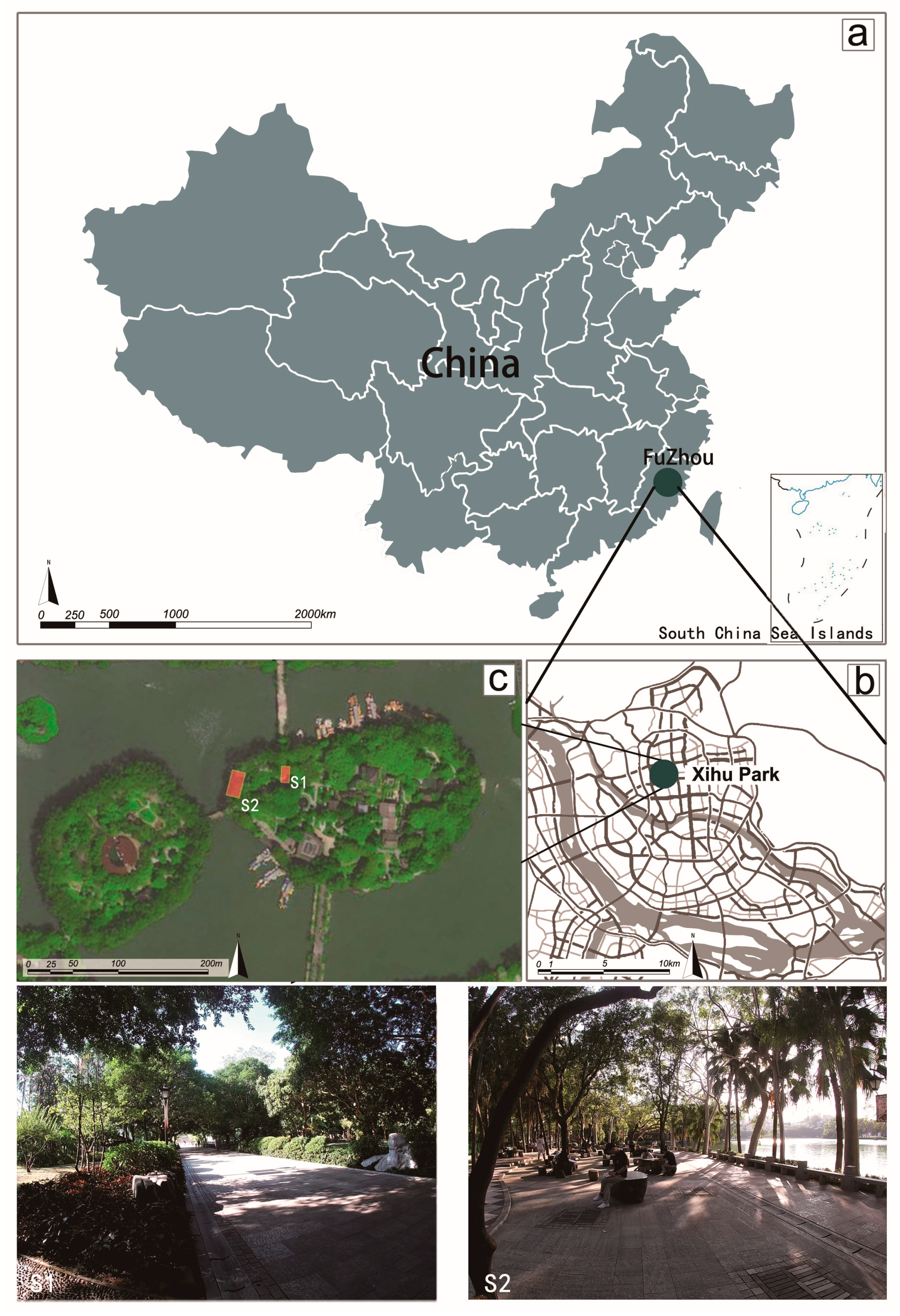
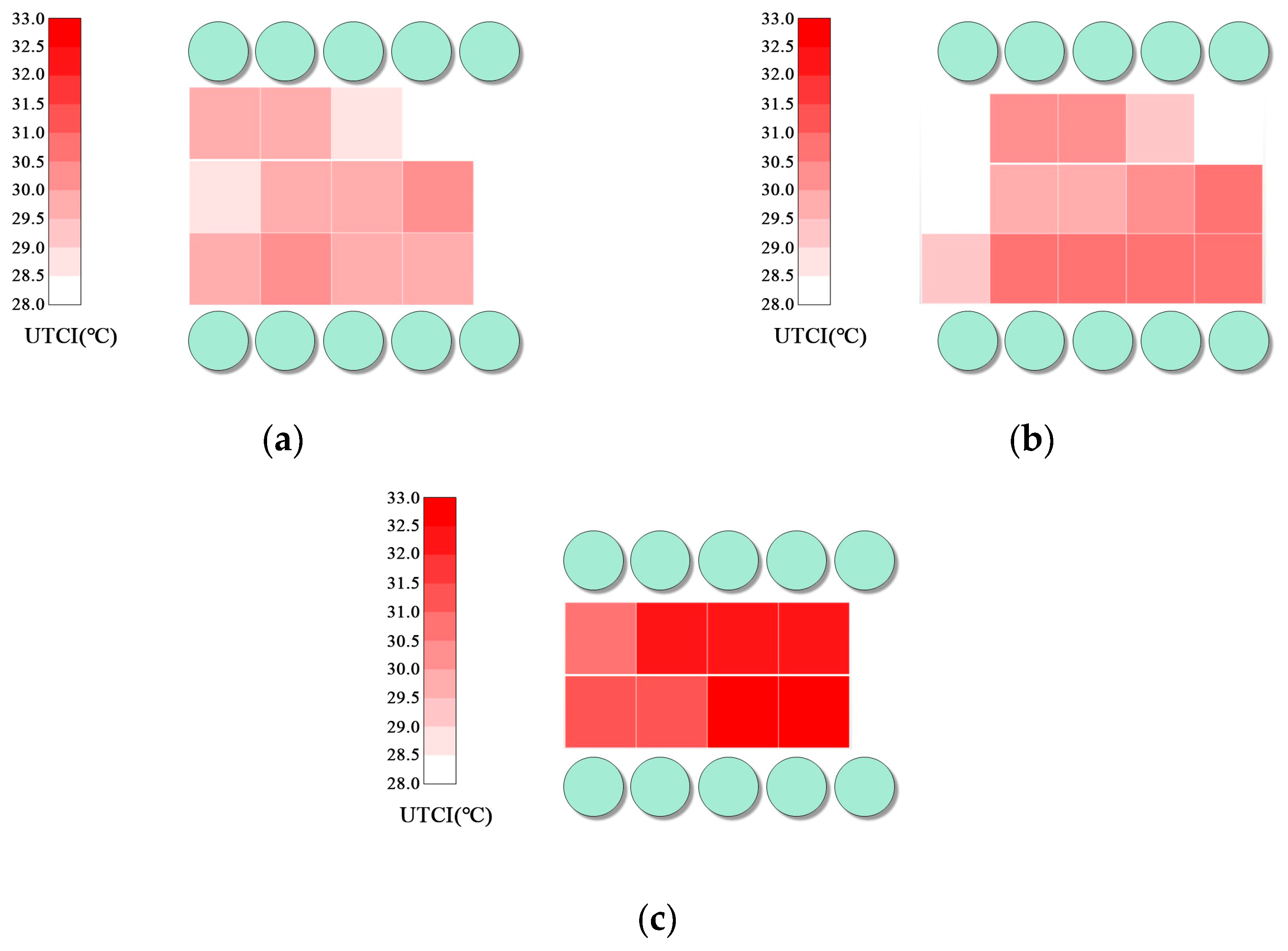
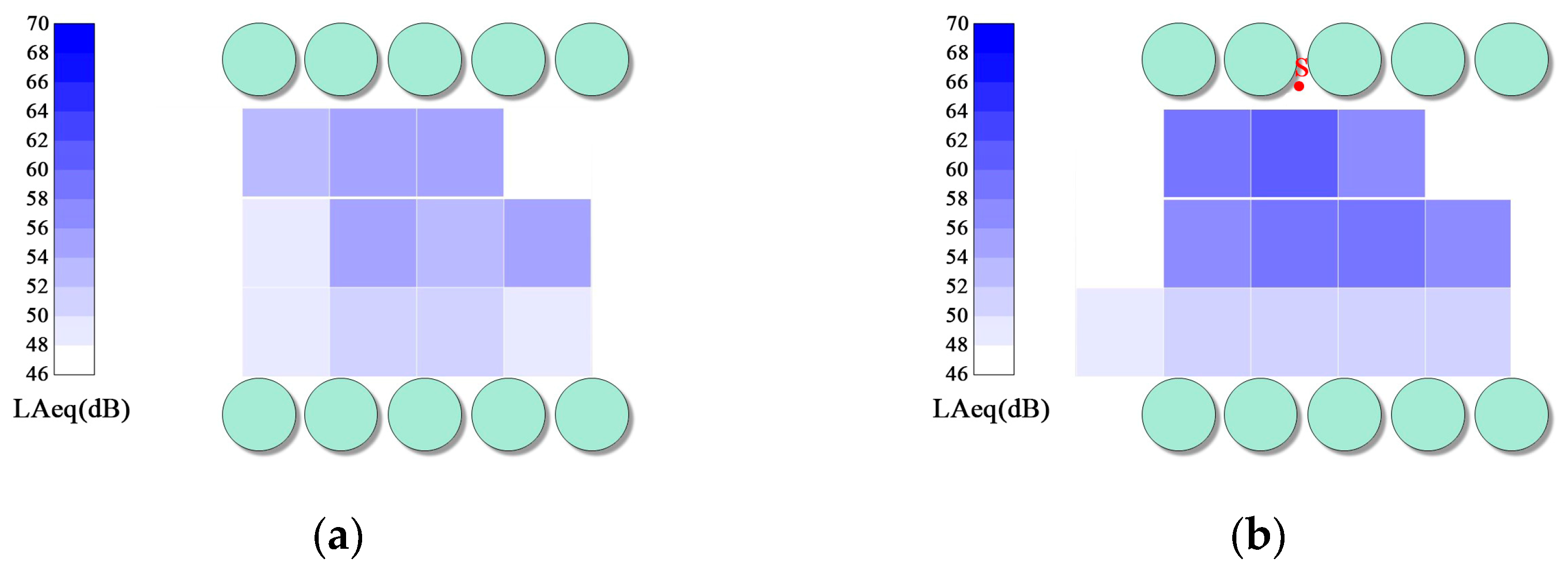
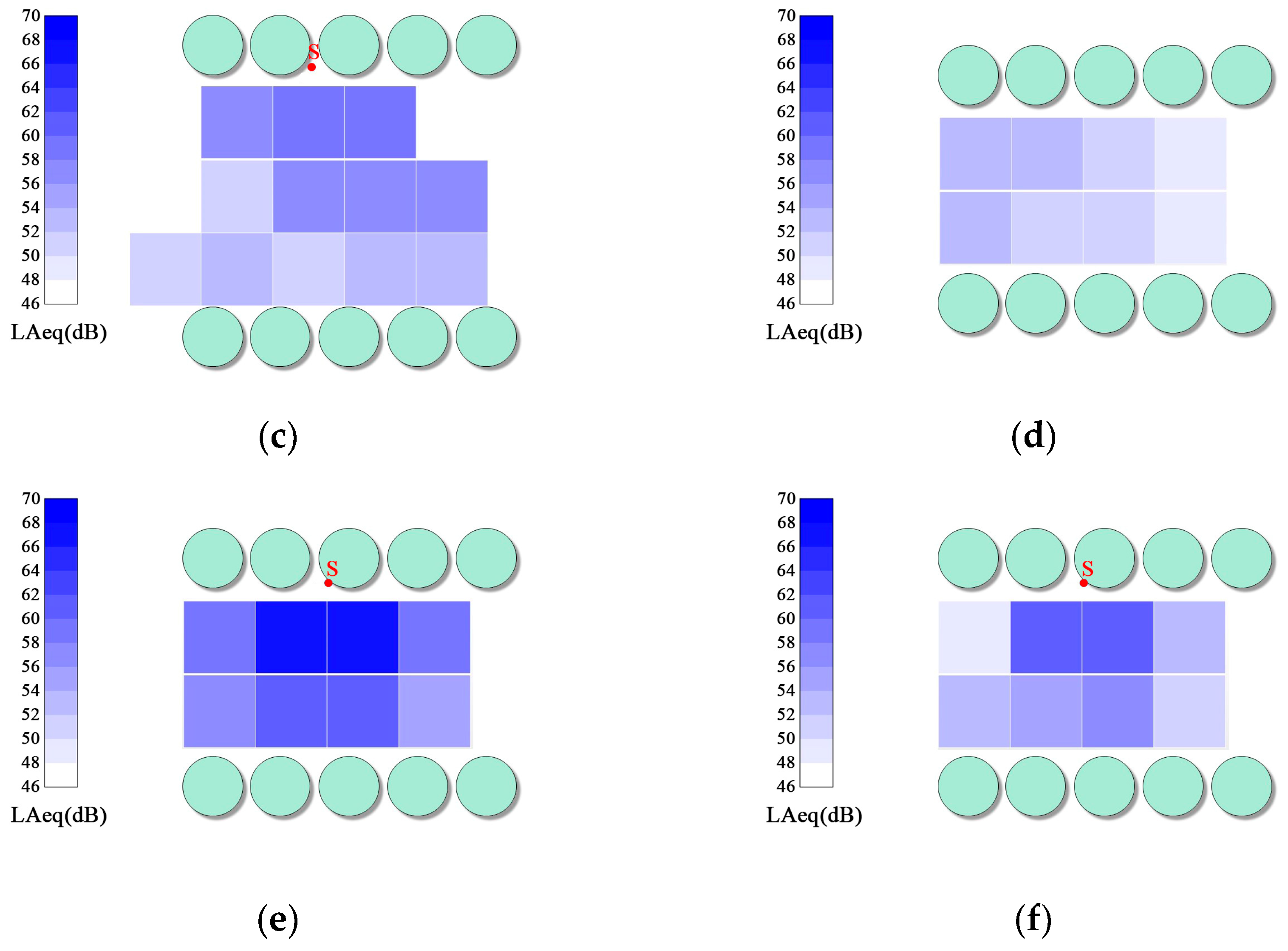

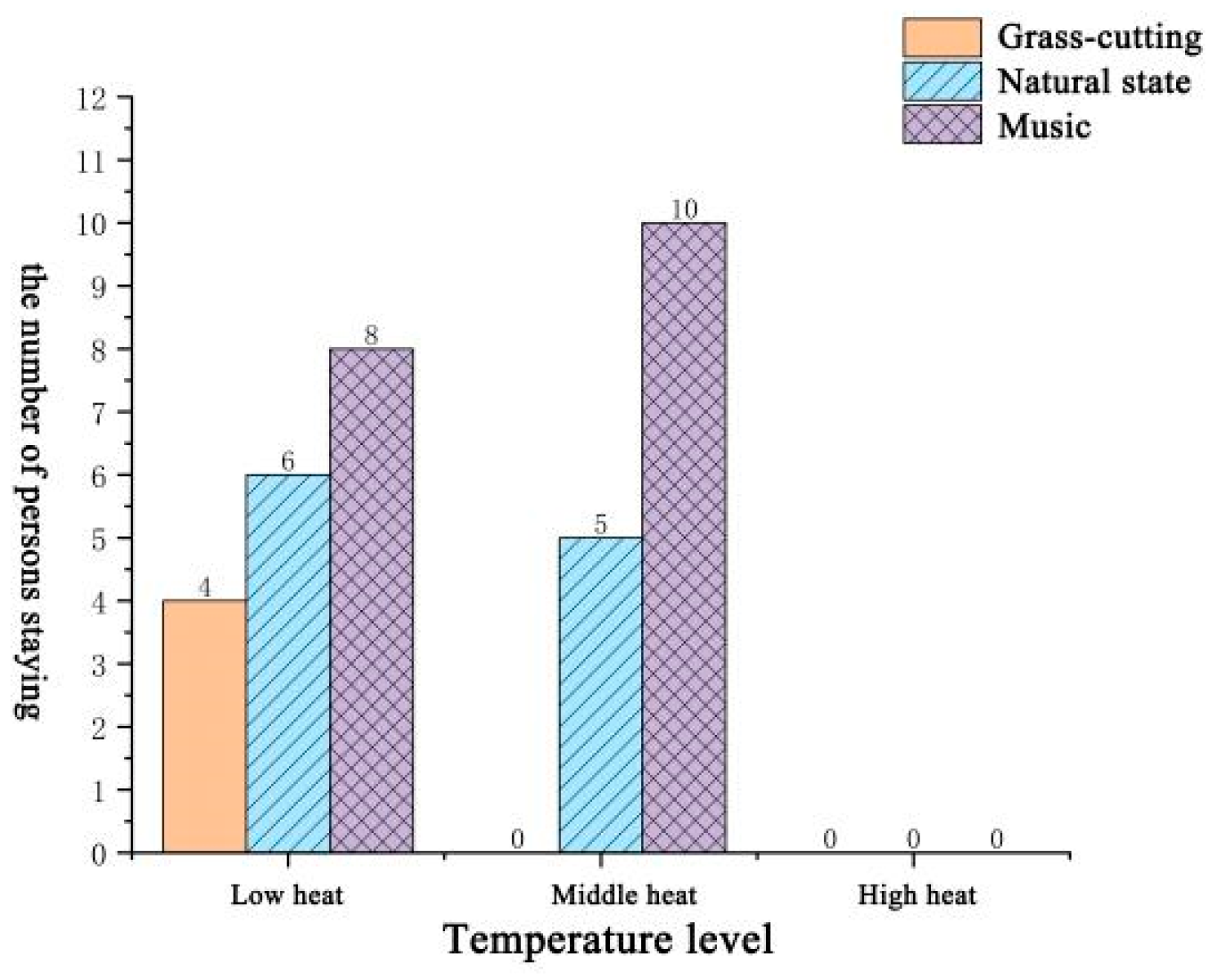
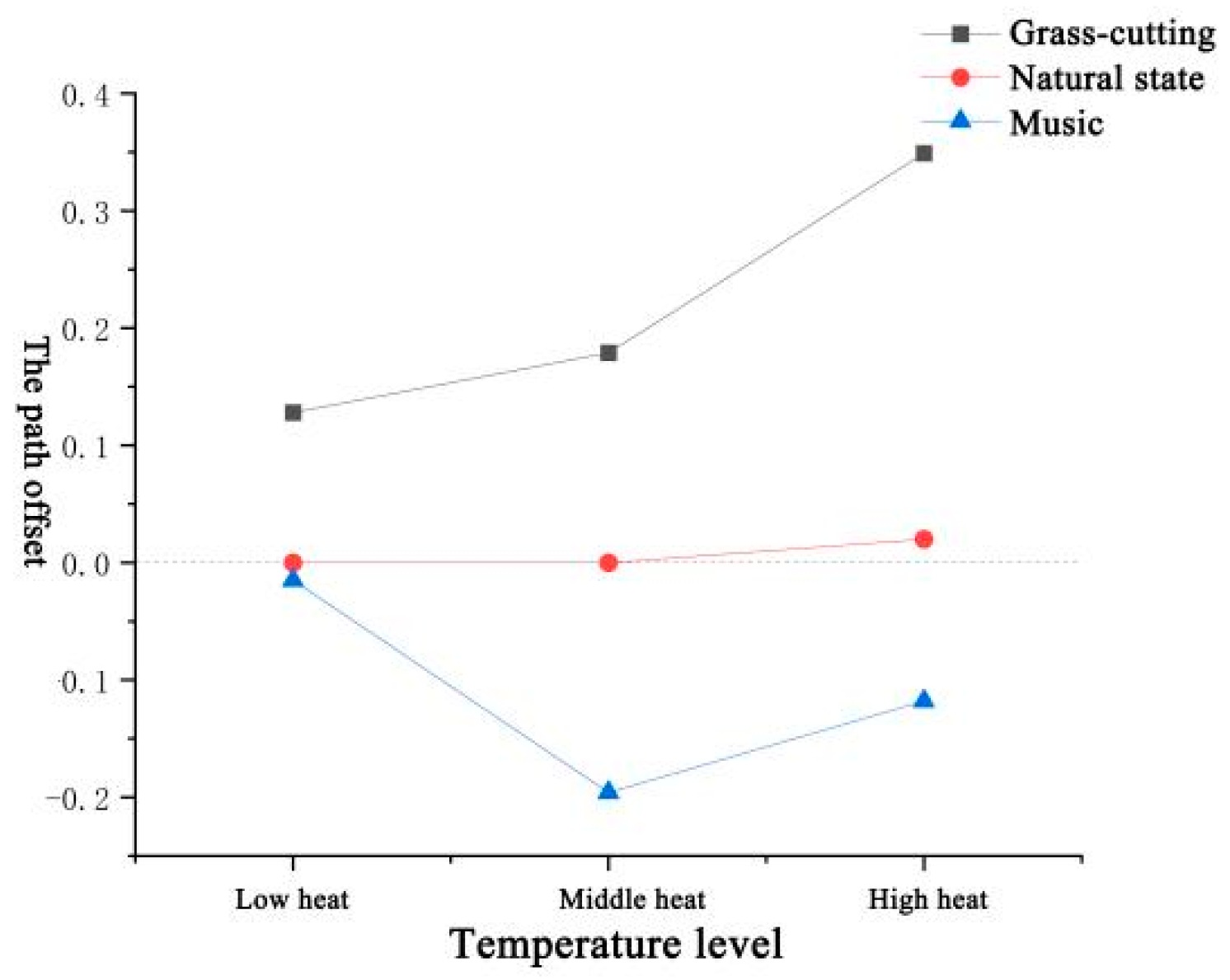
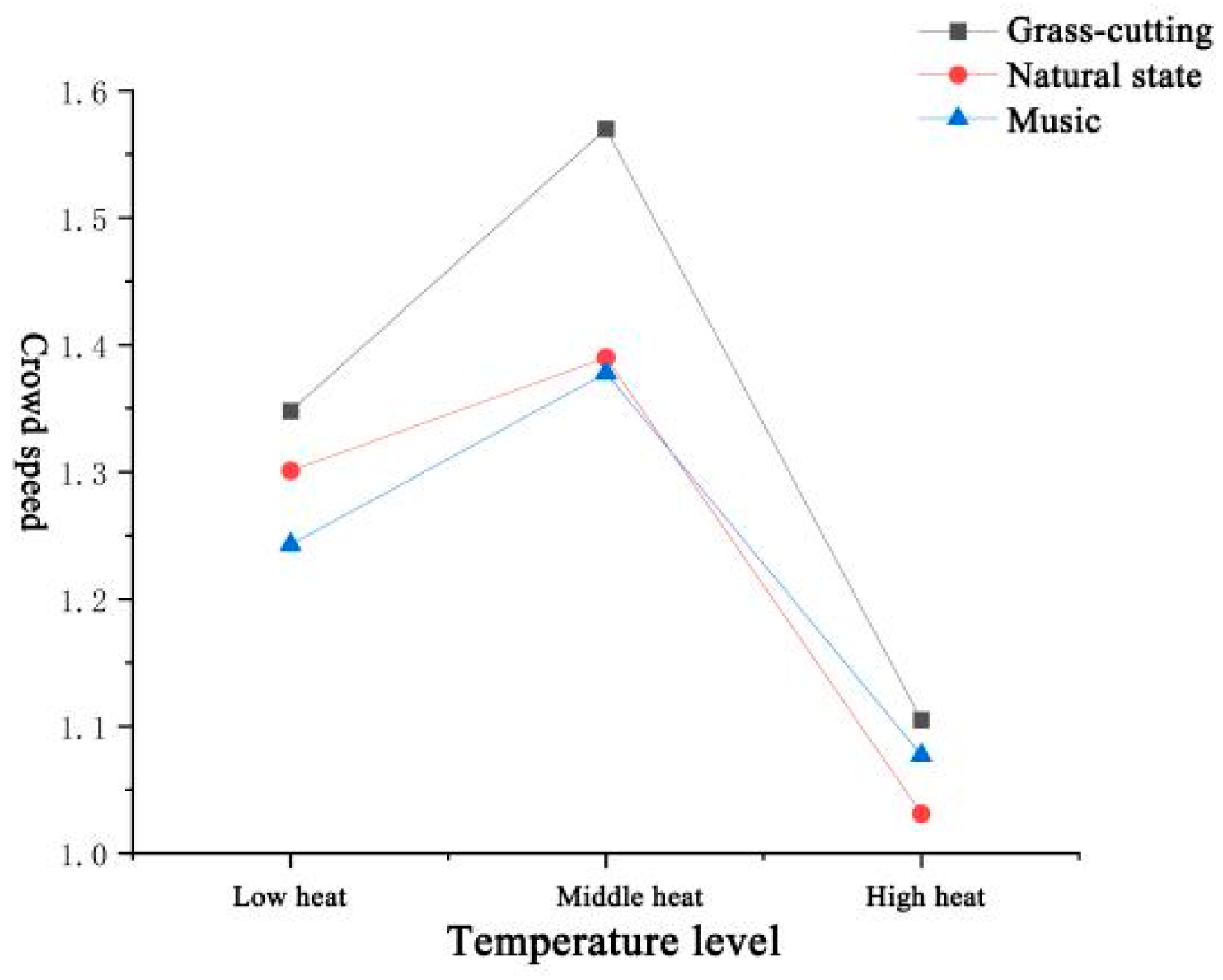
| Instrument | Example | Model | Use |
|---|---|---|---|
| Sound level meter |  | BSWA801 | Measure the sound pressure level |
| Eight-channel high-fidelity recorder |  | SQuadriga II BHS I | Recording different kinds of sounds |
| Camera |  | GoPro 7 | Recording crowd behavior |
| Handheld Mini Weather Station |  | Kestrel5500 | Record air temperature, relative humidity, wind speed and direction |
| Temperature Level | Sound Type | Number of People | Number of Persons Staying | Path Offset | Crowd Speed |
|---|---|---|---|---|---|
| Low heat | Grass cutting | 97 | 4 | 0.128 | 1.348 |
| The natural condition | 130 | 6 | 0 | 1.301 | |
| Music | 153 | 8 | −0.015 | 1.243 | |
| Moderate heat | Grass cutting | 86 | 0 | 0.179 | 1.57 |
| The natural condition | 143 | 5 | 0 | 1.39 | |
| Music | 102 | 10 | −0.196 | 1.378 | |
| High heat | Grass cutting | 79 | 0 | 0.349 | 1.105 |
| The natural condition | 97 | 0 | 0.02 | 1.031 | |
| Music | 102 | 0 | −0.118 | 1.077 |
| Sound Type | Temperature Level | ||
|---|---|---|---|
| Number of people | Correlation coefficient | 0.718 * | −0.505 |
| Sig. (two-tailed) | 0.030 | 0.166 |
| Number of People under Grass-Cutting Condition | Number of People under Natural Condition | Number of People under Music Condition | ||
|---|---|---|---|---|
| Temperature level | Correlation coefficient | −1.000 ** | −0.500 | −0.866 |
| Sig. (two-tailed) | 0.000 | 0.667 | 0.333 |
| Sound Type | Temperature Level | ||
|---|---|---|---|
| Number of persons staying | Correlation coefficient | 0.523 | −0.688 * |
| Sig. (two-tailed) | 0.149 | 0.040 |
| Number of Persons Staying under Grass-Cutting Condition | Number of Persons Staying under Natural Condition | Number of Persons Staying under Music Condition | ||
|---|---|---|---|---|
| Temperature level | Correlation coefficient | −0.866 | −1.000 ** | −0.500 |
| Sig. (two-tailed) | 0.333 | 0.000 | 0.667 |
| Sound Type | Temperature Level | ||
|---|---|---|---|
| Path offset | Correlation coefficient | −0.336 ** | 0.072 |
| Sig. (two-tailed) | 0.000 | 0.112 |
| Source | III Sum of Squares | df | Mean Square | F | Sig. |
|---|---|---|---|---|---|
| Sound | 8.433 | 2 | 4.216 | 32.712 | 0.000 *** |
| Temperature | 0.618 | 2 | 0.309 | 2.396 | 0.092 * |
| Sound × Temperature | 1.631 | 4 | 0.408 | 3.164 | 0.014 ** |
| Sound Type | Temperature Level | Subset at Alpha = 0.05 | |
|---|---|---|---|
| 1 | 2 | ||
| Grass cutting | Low-heat | 0.13 | |
| Moderate-heat | 0.18 | 0.18 | |
| High-heat | 0.35 | ||
| Sig. | 0.810 | 0.099 | |
| Natural condition | Low-heat | 0.00 | |
| Moderate-heat | 0.00 | ||
| High-heat | 0.02 | ||
| Sig. | 0.323 | ||
| Music | Moderate-heat | −0.20 | |
| High-heat | −0.12 | ||
| Low-heat | −0.02 | ||
| Sig. | 0.126 | ||
| Temperature Level | Sound Type | Subset at Alpha = 0.05 | |
|---|---|---|---|
| 1 | 2 | ||
| Low-heat | Music | −0.02 | |
| Natural condition | 0.00 | ||
| Grass cutting | 0.13 | ||
| Sig. | 0.895 | 1.000 | |
| Moderate-heat | Music | −0.20 | |
| Natural condition | 0.00 | ||
| Grass cutting | 0.18 | ||
| Sig. | 1.000 | 0.052 | |
| High-heat | Music | −0.12 | |
| Natural condition | 0.02 | ||
| Grass cutting | 0.35 | ||
| Sig. | 0.312 | 1.000 | |
| Sound Type | Temperature Level | ||
|---|---|---|---|
| Speed | Correlation coefficient | −0.177 ** | −0.367 ** |
| Sig. (two-tailed) | 0.000 | 0.000 |
| Source | III Sum of Squares | df | Mean Square | F | Sig. |
|---|---|---|---|---|---|
| Sound | 1.104 | 2 | 0.552 | 15.475 | 0.000 *** |
| Temperature | 10.920 | 2 | 5.460 | 153.035 | 0.000 *** |
| Sound × Temp | 0.517 | 4 | 0.129 | 3.620 | 0.006 *** |
| Sound Type | Temperature Level | Subset at Alpha = 0.05 | ||
|---|---|---|---|---|
| 1 | 2 | 3 | ||
| Grass cutting | High-heat | 1.11 | ||
| Low-heat | 1.35 | |||
| Moderate-heat | 1.57 | |||
| Sig. | 1.000 | 1.000 | 1.000 | |
| Natural condition | High-heat | 1.03 | ||
| Low-heat | 1.30 | |||
| Moderate-heat | 1.39 | |||
| Sig. | 1.000 | 1.000 | 1.000 | |
| Music | High-heat | 1.08 | ||
| Low-heat | 1.24 | |||
| Moderate-heat | 1.38 | |||
| Sig. | 1.000 | 1.000 | 1.000 | |
| Temperature Level | Sound Type | Subset at Alpha = 0.05 | |
|---|---|---|---|
| 1 | 2 | ||
| Low-heat | Music | 1.24 | |
| Natural condition | 1.30 | 1.30 | |
| Grass cutting | 1.35 | ||
| Sig. | 0.148 | 0.287 | |
| Moderate-heat | Music | 1.38 | |
| Natural condition | 1.39 | ||
| Grass cutting | 1.57 | ||
| Sig. | 0.959 | 1.000 | |
| High-heat | Natural condition | 1.03 | |
| Music | 1.08 | ||
| Grass cutting | 1.11 | ||
| Sig. | 0.053 | ||
Disclaimer/Publisher’s Note: The statements, opinions and data contained in all publications are solely those of the individual author(s) and contributor(s) and not of MDPI and/or the editor(s). MDPI and/or the editor(s) disclaim responsibility for any injury to people or property resulting from any ideas, methods, instructions or products referred to in the content. |
© 2023 by the authors. Licensee MDPI, Basel, Switzerland. This article is an open access article distributed under the terms and conditions of the Creative Commons Attribution (CC BY) license (https://creativecommons.org/licenses/by/4.0/).
Share and Cite
Chen, Y.; Chen, Z.; Lin, S.; Lin, X.; Li, S.; Li, T.; Dong, J. Thermal–Acoustic Interaction Impacts on Crowd Behaviors in an Urban Park. Forests 2023, 14, 1758. https://doi.org/10.3390/f14091758
Chen Y, Chen Z, Lin S, Lin X, Li S, Li T, Dong J. Thermal–Acoustic Interaction Impacts on Crowd Behaviors in an Urban Park. Forests. 2023; 14(9):1758. https://doi.org/10.3390/f14091758
Chicago/Turabian StyleChen, Ye, Ziyi Chen, Shumeng Lin, Xiaoqian Lin, Shuting Li, Taoyu Li, and Jianwen Dong. 2023. "Thermal–Acoustic Interaction Impacts on Crowd Behaviors in an Urban Park" Forests 14, no. 9: 1758. https://doi.org/10.3390/f14091758
APA StyleChen, Y., Chen, Z., Lin, S., Lin, X., Li, S., Li, T., & Dong, J. (2023). Thermal–Acoustic Interaction Impacts on Crowd Behaviors in an Urban Park. Forests, 14(9), 1758. https://doi.org/10.3390/f14091758













